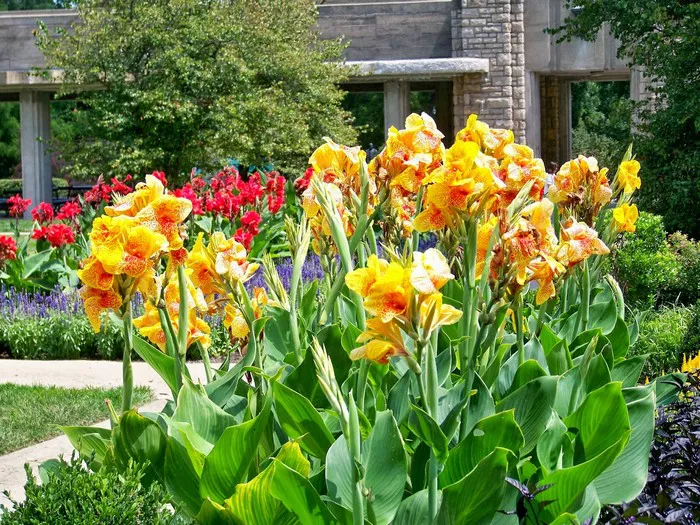Canna plants, with their vibrant blooms and lush foliage, are a popular choice for gardeners seeking to add a tropical flair to their landscapes. However, like any plant, cannas require proper care to thrive and reach their full potential. Whether you’re a seasoned gardener or a beginner, this comprehensive guide will walk you through everything you need to know to successfully cultivate and maintain beautiful canna plants.
Understanding Canna Plants
Before diving into care instructions, it’s essential to understand the basics of canna plants. Cannas, also known as Canna lilies or canna bulbs, are perennial plants native to tropical and subtropical regions of the Americas. They belong to the Cannaceae family and are prized for their large, paddle-shaped leaves and striking flowers, which come in a range of colors including red, orange, yellow, pink, and bi-colors.
Cannas are typically grown from rhizomes, which are underground stems that store nutrients and energy for the plant. Rhizomes should be planted in well-draining soil and can be dug up and divided to propagate new plants.
Site Selection and Planting
Selecting the right location for your canna plants is crucial for their success. Cannas thrive in full sun, so choose a spot in your garden that receives at least 6-8 hours of direct sunlight per day. While they can tolerate partial shade, they may not flower as prolifically in shadier conditions.
When planting cannas, ensure the soil is well-draining to prevent waterlogging, which can lead to root rot. Sandy loam soil amended with organic matter such as compost or aged manure works well for cannas. Plant rhizomes horizontally, with the eyes facing upward, and cover them with 2-3 inches of soil.
Watering and Moisture Management
Proper watering is essential for the health of canna plants, especially during the growing season. Water newly planted cannas thoroughly to settle the soil around the rhizomes, then maintain even moisture throughout the growing season. Water deeply but infrequently, allowing the soil to dry out slightly between waterings.
During periods of hot weather or drought, increase watering frequency to prevent the soil from drying out completely. Mulching around the base of the plants can help retain moisture and regulate soil temperature.
Fertilization
Canna plants are heavy feeders and benefit from regular fertilization to support their vigorous growth and abundant flowering. Apply a balanced, slow-release fertilizer formulated for flowering plants in early spring as new growth emerges. Follow package instructions for application rates, taking care not to over-fertilize, which can lead to excessive foliage growth at the expense of flowers.
Throughout the growing season, supplement with liquid fertilizer every 4-6 weeks to provide additional nutrients. Water-soluble fertilizers can be applied directly to the soil or diluted and applied as a foliar spray.
Pruning and Deadheading
Regular pruning and deadheading can help keep canna plants looking their best and encourage continued blooming. Remove spent flowers promptly to prevent the plant from directing energy into seed production. Additionally, trim away any dead or yellowing leaves to improve air circulation and reduce the risk of disease.
In late fall or early winter, after the first frost, cut back canna foliage to within a few inches of the ground. This helps prevent the spread of disease and protects the rhizomes from cold damage. Mulch heavily over the rhizomes to insulate them during winter dormancy.
Pest and Disease Management
While relatively resistant to pests and diseases, canna plants can occasionally fall victim to common garden pests such as aphids, spider mites, and caterpillars. Inspect plants regularly for signs of infestation, such as distorted foliage, stippling, or webbing, and treat affected plants promptly with insecticidal soap or neem oil.
Cannas are also susceptible to fungal diseases such as leaf spot and rust, particularly in humid conditions. To prevent fungal issues, avoid overhead watering, which can promote moisture accumulation on foliage. Provide adequate spacing between plants to promote air circulation and remove and destroy infected foliage promptly.
Overwintering Cannas
In regions with cold winters, cannas may need special care to survive the colder months. Before the first frost, dig up rhizomes carefully, taking care not to damage them, and shake off excess soil. Allow rhizomes to dry in a cool, dry location for a few days to cure.
Once dry, store rhizomes in a breathable medium such as peat moss or vermiculite in a cool, dark location with temperatures around 40-50°F (4-10°C). Check stored rhizomes periodically for signs of rot or dehydration, discarding any that appear damaged.
In spring, as temperatures warm and the risk of frost has passed, replant canna rhizomes in prepared soil and resume regular care and maintenance.
Conclusion
With their stunning flowers and lush foliage, canna plants add a touch of tropical elegance to any garden or landscape. By providing proper care, including site selection, watering, fertilization, pruning, and pest management, you can enjoy vibrant and healthy cannas year after year. Whether you’re a seasoned gardener or a beginner, following these guidelines will help you cultivate beautiful canna plants that are the envy of the neighborhood.


